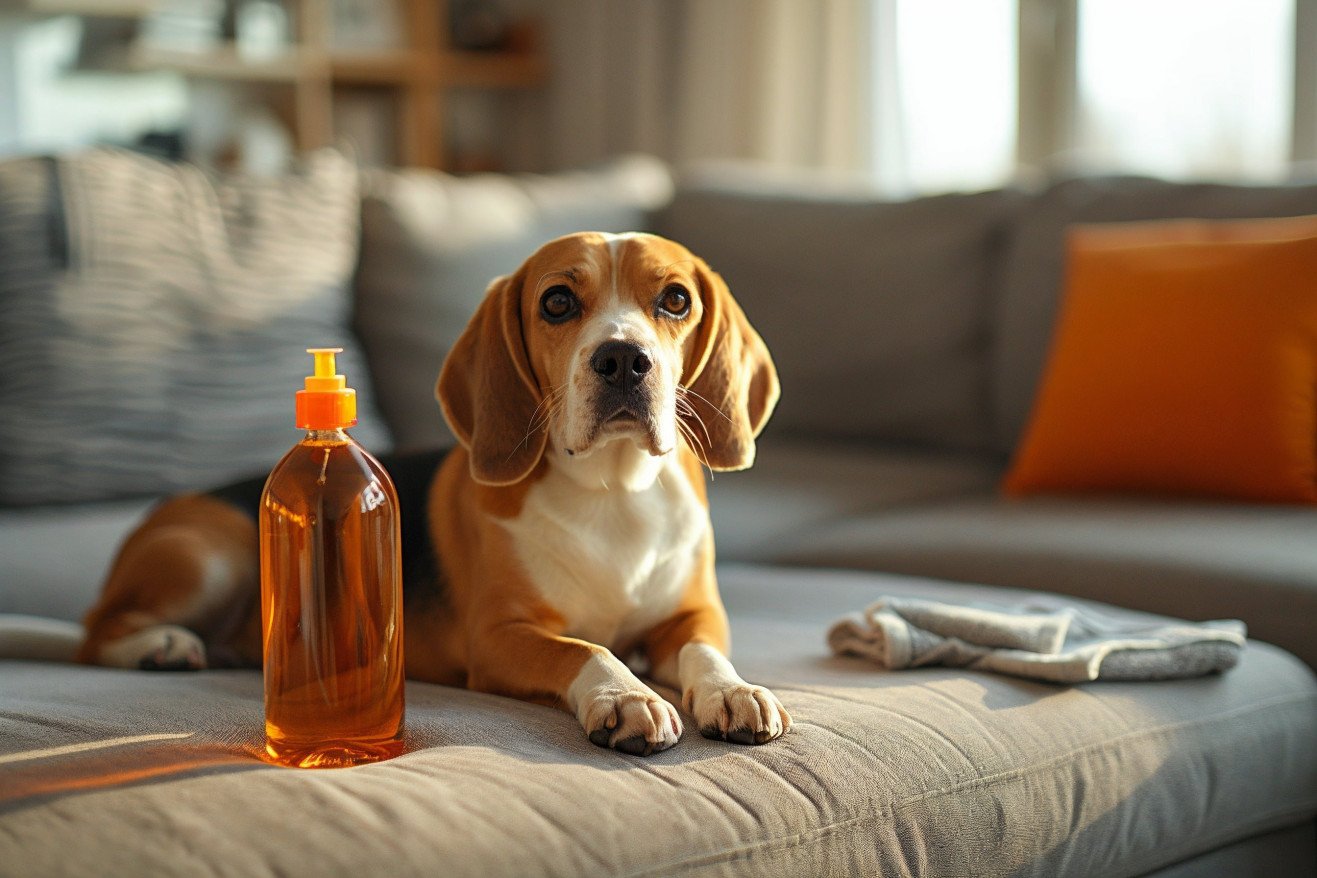How to Get Dog Smell Out of Your Couch: Tried-and-True Methods
14 February 2024 • Updated 14 February 2024

If you’re tired of the unmistakable scent of your four-legged friend taking over your go-to sofa, there are a few ways to get rid of it. One way to get dog smell out of your couch is to cover the entire surface with baking soda, let it sit for at least eight hours, and then vacuum it up.
Another option is to fill a spray bottle with white vinegar and spritz the couch. If the smell is still there, you can try an enzymatic cleaner that’s specifically made to get rid of pet smells.
Throughout this article, we’ll take a deep dive into this relatable issue by looking at a variety of research and expert insights from fields like chemistry, home economics, and textile sciences.
We’ll examine how various cleaning techniques and products can work to eliminate the smell of dogs from your couch’s material. By assessing the science of odor elimination and the efficiency of the suggested methods, we aim to provide you with the information necessary to rejuvenate your home and foster a more inviting living area.
What are the ways to get rid of the dog smell on your couch?
Breaking Down the Science of Dog Smell in Couches
The first step in getting rid of dog smell in couches is to understand the science behind it. At a molecular level, the molecules that make up dog smell are absorbed by the fibers in the couch. Studies from McGill University show that activated carbon filters and compounds like baking soda can absorb these molecules, and that bacteria-based enzymes can break them down.
Meanwhile, studies from the University of York show that bacterial enzymes can convert non-smelly molecules into smelly ones, which explains why enzymatic cleaners that target these enzymes are so effective.
Even simpler, more natural solutions like baking soda and vinegar are part of this molecular process.
According to RSC Education, for a molecule to be detected by the human nose, it must be volatile and soluble, and these common kitchen ingredients can help eliminate dog smell by absorbing and neutralizing these molecules.
However, the way that different materials absorb these molecules can also influence how effectively dog odor is eliminated from a couch, as the distinct characteristics of each material can affect how well they react with and take in these molecules.
Natural Remedies to Get Rid of Dog Smells on Your Couch
Not only do natural remedies like baking soda, vinegar, and essential oils work to eliminate dog smells, but they also offer a safer alternative to chemical air fresheners.
Baking soda, which is well-known for its ability to absorb odor molecules, is a great option for pet parents.
Vinegar, which is known for its antibacterial properties, can also help get rid of the odors that your dog leaves behind. Greenopedia recommends mixing equal parts vinegar and water in a spray bottle to create a simple natural deodorizer to spritz on your couch. Then, sprinkle baking soda on the couch, let it sit overnight, and vacuum it up for a fresh-smelling finish.
Essential oils, like those from Plant Therapy, can also help add a pleasant aroma to the mix, but it’s important to ensure that they’re safe for pets. Koti Beth provides a useful recipe for a spray that combines high-proof vodka, water, and a blend of pet-safe essential oils to create a natural textile deodorizer.
These natural remedies are also better for the planet and your health since they’re nontoxic and often biodegradable, unlike many synthetic alternatives. Make sure to patch test the solution on a small, hidden area of your upholstery before using it to avoid any unpleasant surprises. These easy, eco-friendly remedies will help you keep your home smelling fresh and inviting while also respecting our understanding of different textile types and their unique care needs.
The Role of Textiles in Retaining Dog Smells
While the type of cleaning method used to rid your couch of pet odors is important, the type of textile used to make the couch is also a key factor. A study in Applied Sciences found that the type of fiber used in textiles has a significant impact on the retention and release of volatile organic compounds (VOCs) that contribute to body odors.
In general, natural fibers like wool and cotton retain less odor than synthetic fibers like polyester and polyamide, which hold on to odors more tightly. This hierarchy of odor retention emphasizes the importance of choosing textiles wisely.
There are also differences in the cleanability of textiles. For example, leather requires special cleaners and can be damaged if not properly treated, while synthetic textiles may be more compatible with water-based cleaning solutions.
As a review in ScienceDirect notes, current research in textile development is focused on creating sustainable textiles that include built-in odor control, which could change the game in terms of what textiles are used in furniture. This move toward textiles that resist odors can give pet owners more options for keeping their homes smelling fresh.
A study by Rachel H McQueen and colleagues points out that the interaction between upholstery and odor-causing agents is complex and includes not only the textiles but also the soils that build up on them and the cleaning methods used to wash them.
Given the changes in textile development and their impact on the environment, it’s important to remember that the textiles used in furniture can have a big impact on how successfully pet odors can be managed in the long run.
How to Deal With Dog Smell: The Impact of Environmental Conditions
Temperature and humidity play a major role in how long dog odors stick around and how easily they can be removed. Ecosorb explains that higher temperatures activate the molecules that cause odors, making them more volatile and therefore more pungent.
This is especially relevant in the spring and summer when we tend to notice our dogs’ smells more than ever. The Monell Chemical Senses Center’s study found that people are more sensitive to odors in warmer, more humid environments, which makes pet odors more noticeable.
Good ventilation is key to dealing with these indoor odors. Proper air flow can help dilute and remove air that’s been made smelly by odors and replace it with fresh air, which in turn can reduce the strength of the smell. Air purifiers can also help by capturing and breaking down pet odors, leading to better air quality and a more pleasant environment.
Keeping the home at a comfortable temperature and humidity level can also help prevent odors from building up. This may mean running the air conditioning in the summer and using a dehumidifier in the winter.
It can also be helpful to adjust your cleaning schedule based on the season. For example, you may need to clean more often or more thoroughly in the summer when the temperature and humidity are higher to keep your home smelling fresh.
Expert Opinions on How to Get Rid of Dog Smells on Your Couch
Home cleaning professionals and veterinarians can offer a wealth of knowledge when it comes to getting rid of dog smells on your couch. Many experts suggest a combination of regular cleaning and more advanced techniques to get rid of stubborn smells.
For example, regular grooming and bathing of your dog can help reduce the odors they produce, according to Angry Orange. In the short term, high-quality vacuums like the Dyson Cyclone V10 Animal and textile deodorizers can assist in eliminating pet hair and dander, according to The Family Handyman.
Professional services, like steam cleaning, can offer a more comprehensive solution for deeply set-in smells. It’s important to note that steam cleaning should not be used on fabrics that have been soiled with urine, as it can set the stain, according to This Old House.
However, for general smells, professional steam cleaning can help get rid of smells by penetrating deep into the fibers. If at-home solutions like baking soda or enzymatic cleaners aren’t working, it may be time to turn to professional equipment and expertise.
Use a combination of at-home solutions and professional services based on the severity of the odor and the material of your upholstery. While regular maintenance is important for keeping odors away, don’t hesitate to seek professional help if you’re confronting a persistent odor on your preferred sofa.
Final Thoughts: Clean Spaces and Happy Dogs
Throughout our quest to take back our clean spaces from the clutches of dog smells, we have covered a variety of methods that are both scientifically and practically sound. The war against these stubborn smells starts at the molecular level, where odor molecules are absorbed, neutralized, or broken down. Baking soda and vinegar are shown to be the heroes in this war, giving pet parents safe and eco-friendly options.
We have also noticed that the type of material matters, as it can alter how odorous compounds engage with it and, consequently, how effective cleaning methods are.
Meanwhile, keeping up with the cleanliness of our spaces by making sure they are well-ventilated and using air purifiers is key to keeping odors at bay. Meanwhile, cleaning professionals have shared their knowledge, and cleaning technology has given us the tools to take on even the toughest situations.
To keep your space clean and inviting, remember to stay on top of pet grooming and consider the benefits of choosing furniture with pet-friendly fabrics. By using the information we’ve covered here, you can create a space that you and your dog can enjoy without the signs of pet ownership.


